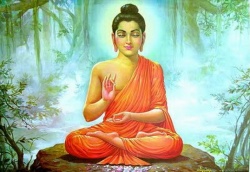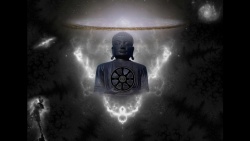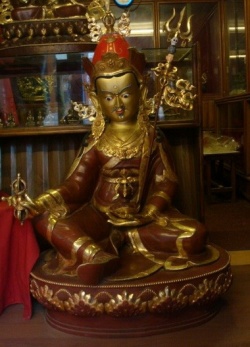The Buddha on Non-Duality
(The following is written by Ajahn Amaro on the teachings of Non-Duality, Anatta and Emptiness by Buddha, as well as being a great description of Stages 5 & 6 of Thusness/PasserBy's Seven Stages of Enlightenment)
Ancient Teachings on Nonabiding
This principle of nonabiding is also contained within the ancient Theravada teachings. It wasn’t just Ajahn Chah’s personal insight or the legacy of some stray Nyingmapa lama who wandered over the mountains and fetched up in northeast Thailand 100 years ago. Right in the Pali Canon, the Buddha points directly to this. In the Udana (the collection of “Inspired Utterances” of the Buddha), he says:
There is that sphere of being where there is no earth, no water, no fire, nor wind; no experience of infinity of space, of infinity of consciousness, of no-thingness, or even of neither-perception-nor-non-perception; here there is neither this world nor another world, neither moon nor sun; this sphere of being I call neither a coming nor a going nor a staying still, neither a dying nor a reappearance; it has no basis, no evolution, and no support: it is the end of dukkha. (ud. 8.1)
Rigpa, nondual awareness, is the direct knowing of this. It’s the quality of mind that knows, while abiding nowhere.
Another teaching from the same collection recounts the story of a wanderer named Bahiya. He stopped the Buddha on the street in Savatthi and said, “Venerable Sir, you are the Samana Gotama. Your Dharma is famous throughout the land. Please teach me that I may understand the truth.”
The Buddha replied, “We’re on our almsround, Bahiya. This is not the right time.”
“Life is uncertain, Venerable Sir. We never know when we are going to die; please teach me the Dharma.”
This dialogue repeats itself three times. Three times over, the Buddha says the same thing, and Bahiya responds in the same way. Finally, the Buddha says, “When a Tathagata is pressed three times, he has to answer. Listen carefully, Bahiya, and attend to what I say:
In the seen, there is only the seen, in the heard, there is only the heard, in the sensed, there is only the sensed, in the cognized, there is only the cognized. Thus you should see that
indeed there is no thing here;
this, Bahiya, is how you should train yourself. Since, Bahiya, there is for you
in the seen, only the seen,
in the heard, only the heard,
in the sensed, only the sensed,
in the cognized, only the cognized, and you see that there is no thing here, you will therefore see that
indeed there is no thing there.
As you see that there is no thing there, you will see that
you are therefore located neither in the world of this, nor in the world of that,
nor in any place
betwixt the two.
This alone is the end of suffering.” (ud. 1.10)
Upon hearing these words, Bahiya was immediately enlightened. Moments later he was killed by a runaway cow. So he was right: life is uncertain. Later Bahiya was awarded the title of “The Disciple Who Understood the Teaching Most Quickly.”
“Where” Does Not Apply
What does it mean to say, “There is no thing there”? It is talking about the realm of the object; it implies that we recognize that “the seen is merely the seen.” That’s it. There are forms, shapes, colors, and so forth, but there is no thing there. There is no real substance, no solidity, and no self-existent reality. All there is, is the quality of experience itself. No more, no less. There is just seeing, hearing, feeling, sensing, cognizing. And the mind naming it all is also just another experience: “the space of the Dharma hall,” “Ajahn Amaro’s voice,” “here is the thought, ‘Am I understanding this?’ Now another thought, ‘Am I not understanding this?’”
There is what is seen, heard, tasted, and so on, but there is no thing-ness, no solid, independent entity that this experience refers to.
As this insight matures, not only do we realize that there is no thing “out there,” but we also realize there is no solid thing “in here,” no independent and fixed entity that is the experiencer. This is talking about the realm of the subject.
The practice of nonabiding is a process of emptying out the objective and subjective domains, truly seeing that both the object and subject are intrinsically empty. If we can see that both the subjective and objective are empty, if there’s no real “in here” or “out there,” where could the feeling of I-ness and meness and my-ness locate itself? As the Buddha said to Bahiya, “You will not be able to find your self either in the world of this subject or in the world of that object or anywhere between the two.”
There is a similar and much lengthier exchange between the Buddha and Ânanda in the Shurangama Sutra, which is a text much referred to in the Ch’an school of the Chinese tradition. For pages and pages the Buddha asks Ânanda, in multifarious ways, if he can define exactly where his mind is. No matter how hard he tries, Ânanda cannot establish it precisely. Eventually he is forced to the conclusion that “I cannot find my mind anywhere.”
But the Buddha says, “Your mind does exist, though, doesn’t it?”
Ânanda is finally drawn to the conclusion that “where” does not apply.
Aha!
This is the point that these teachings on nonabiding are trying to draw us to. The whole concept and construct of where-ness, the act of conceiving ourselves as this individual entity living at this spot in space and time, is a presumption. And it’s only by frustrating our habitual judgments in this way that we’re forced into loosening our grip.
This view of things pulls the plug, takes the props away, and, above all, shakes up our standard frames of reference. This is exactly what Ajahn Chah did with people when he asked, “If you can’t go forward and you can’t go back and you can’t stand still, where can you go?” He was pointing to the place of nonabiding: the timeless, selfless quality that is independent of location.
Interestingly enough, some current scientific research has also reached a comparable conclusion about the fundamental nature of matter. In the world of quantum physics, scientists now use such terms as “the well of being” or “the sea of potential” to refer to the primordial level of physical reality from which all particles and energies crystallize and into which they subsequently dissolve. The principle of non-locality in this realm means that the “place where something happens” cannot truly be defined, and that a single event can have exactly simultaneous effects in (apparently) widely separated places. Particles can accurately be described as being smeared out over the entirety of time and space.
Terms like “single place” and “separate places” are seen to apply only as convenient fictions at certain levels of scale; at the level of the ultimate field, the sea of quantum foam, “place” has no real meaning. When you get down into the fine, subatomic realm, where-ness simply does not apply. There is no there there. Whether this principle is called nonabiding or non-locality, it’s both interesting and noteworthy that the same principle applies in both the physical and mental realms. For the intellectuals and rationalists among us, this parallel is probably very comforting.
I first started to investigate this type of contemplation when I was on a long retreat in our monastery and doing a lot of solitary practice. It suddenly occurred to me that even though I might have let go of the feeling of self—the feeling of this and that and so on—whatever the experience of reality was, it was still “here.” There was still here-ness. For several weeks I contemplated the question, “Where is here?” Not using the question to get a verbal answer, more just to illuminate and aid the abandonment of the clinging that was present.
Recognizing this kind of conditioning is half the job— recognizing that, as soon as there is a here-ness, there is a subtle presence of a there-ness. Similarly, establishing a “this,” brings up a “that.” As soon as we define “inside,” up pops “outside.” It’s crucial to acknowledge such subtle feelings of grasping; it happens so fast and at so many different layers and levels.
This simple act of apprehending the experience is shining the light of wisdom onto what the heart is grasping. Once the defilements are in the spotlight, they get a little nervous and uncomfortable. clinging is the focus of our awareness, it can’t function properly. In short, clinging can’t cling if there is too much wisdom around. Clinging operates best when we are not looking. When clinging is the focus of our awareness, it can’t function properly. In short, clinging can’t cling if there is too much wisdom around.




